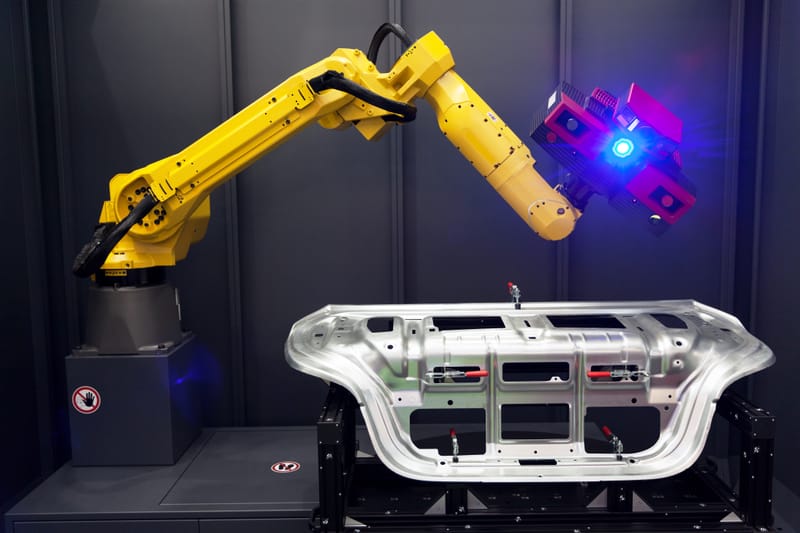Manufacturing and production

The Manufacturing Industry in Transformation
Digitalization and Industry 4.0 The fourth industrial revolution, known as Industry 4.0, is at the heart of changes in manufacturing. It involves the integration of digital technologies such as the Internet of Things (IoT), Artificial Intelligence (AI), Big Data, and Cloud Computing into manufacturing processes. These technologies enable higher automation, improved efficiency and flexibility, and the realization of smart factories where systems communicate autonomously and optimize processes.
Challenges:
- The transition to digital systems requires significant investments in technology and training.
- Data security and defense against cyber threats are increasingly important.
Opportunities:
- Increased production efficiency and cost reductions through optimized processes.
- Improved product quality and flexibility to respond to market changes.
Sustainability and Circular Economy Sustainability is another key trend influencing the manufacturing industry. Companies aim to reduce their environmental footprints by using resources more efficiently and minimizing waste. The integration of principles of the circular economy, where products are recycled or reused at the end of their lifecycle, is gaining importance.
Challenges:
- Transitioning to sustainable production methods can be costly.
- The need to comply with stricter environmental regulations and standards.
Opportunities:
- Development of new business models that prioritize sustainability.
- Enhancement of brand perception and customer demand through environmentally friendly practices.
Changes in Research and Development Research and development in the manufacturing industry are increasingly shaped by the opportunities of digitalization. For example, Virtual Reality (VR) and Augmented Reality (AR) are used for product designs and prototyping, reducing development times and accelerating innovation cycles.
Challenges:
- The need for continuous innovation and adaptation to new technologies.
- Growing demand for professionals with specialized knowledge in new technologies.
Opportunities:
- Development of innovative products and solutions through advanced research methods.
- Shortening of time to market through more efficient development processes.
Administrative Changes At the administrative level, digitization is leading to a transformation of work practices. Cloud-based solutions, automated systems for resource and supply chain management, and digital collaboration platforms have become standard.
Challenges:
- Managing digital transformation and ensuring IT security.
- Adapting to changes in business processes and work models.
Opportunities:
- Improved decision-making through real-time data analysis and reporting.
- Increasing global competitiveness through efficient and scalable processes.
Project Management
- Planning and monitoring of manufacturing projects: Includes scheduling, resource allocation, budgeting, and progress monitoring to ensure timely and budget-compliant project completion.
- Risk management: Identification, assessment, and management of project risks to proactively address and minimize potential issues.
- Stakeholder communication: Effective communication and coordination with all project stakeholders, including suppliers, customers, and project teams.
Process Management
- Lean manufacturing and process optimization: Analysis and optimization of manufacturing processes to increase efficiency, reduce waste, and improve product quality.
- Supply chain management: Optimization of the supply chain to improve logistics, reduce costs, and ensure timely delivery.
- Implementation of quality assurance systems: Development and implementation of systems for quality assurance and control to ensure compliance with standards and customer expectations.
Requirements Engineering (including Risk Analyses)
- Requirements analysis for manufacturing systems: Defining and documenting technical and operational requirements for manufacturing systems and processes.
- Risk analysis and assessment: Conducting risk analyses to identify potential risks in manufacturing processes and systems and developing measures to mitigate them.
- Change management: Managing changes in requirements and specifications to ensure flexibility and adaptability in projects.
System Modeling
- Digital twins and simulation: Creating digital twins and conducting simulations to optimize manufacturing processes and predict system behavior under different conditions.
- 3D modeling and CAD services: Development of 3D models and CAD drawings for product design, tooling, and manufacturing planning.
- Integration of manufacturing systems: Design and implementation of integrated manufacturing systems that harmonize various technologies and processes.
Software Development
- Development of manufacturing management software: Customized software solutions for manufacturing management, including Enterprise Resource Planning (ERP) systems, Manufacturing Execution Systems (MES), and quality management systems.
- IoT and automation solutions: Development of IoT-based solutions for automating manufacturing processes and real-time data collection and analysis.
- Adaptation and integration of software solutions: Customizing existing software products and integrating them into the company's IT landscape to enable seamless workflows and data flows.